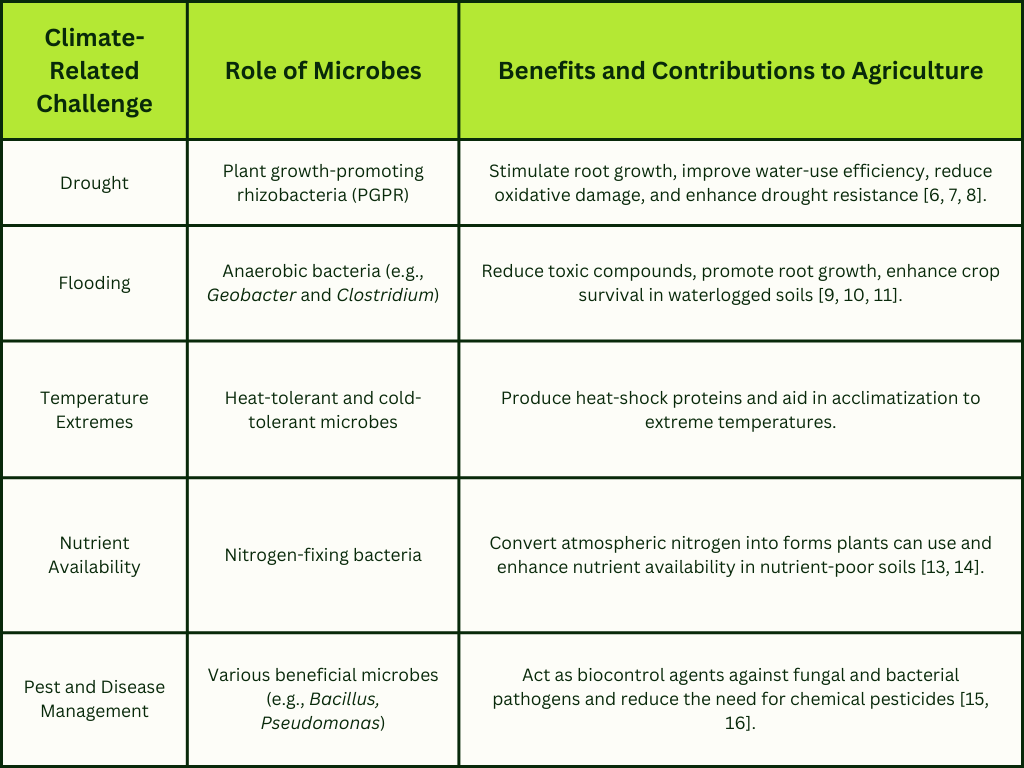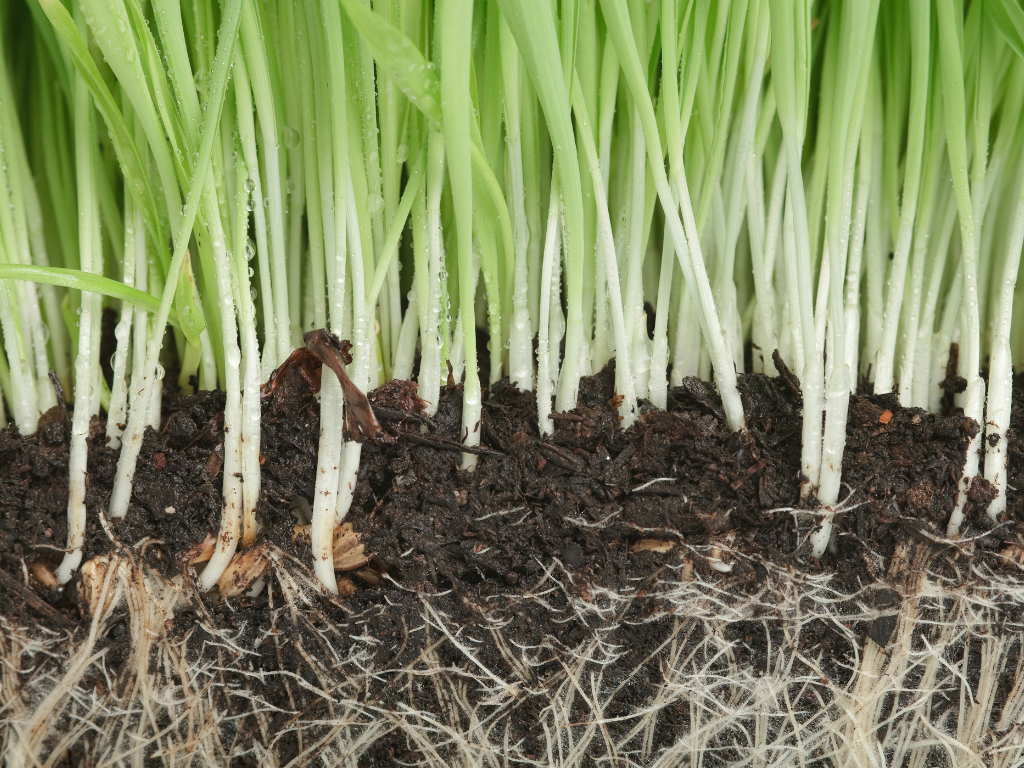The Role of Microbes in Climate-Resilient Agriculture
Climate Change and Agriculture
Climate change is one of the significant challenges that the agricultural sector is facing, with rising temperatures, changing precipitation patterns, and an increase in extreme weather events [1]. These threaten crop yields and food security worldwide. However, amidst these challenges, microbes have emerged at the forefront of efforts to develop climate-resilient agriculture.
Microbial and Plant Partnership
Microbes have co-evolved with plants for millions of years [2,3], leading to intricate and mutually beneficial partnerships. One of the most well-known examples of such symbiotic relationships is mycorrhizal fungi, extending under plant roots [3]. These fungi provide several benefits to the plants they are in association with, such as improved water and nutrient uptake increased resistance against diseases [4], and nutrient mobilization from organic substrates. During drought conditions, these partnerships become crucial, as mycorrhizal fungi help plants access water stored deeper in the soil [5], improving their resilience to water scarcity.
Beneficial Microbes for Drought Resistance
Drought is one of the most important abiotic stress factors that disrupt the growth and development of plants due to climate change [6]. Researchers are exploring the potential of specific microbes, particularly plant growth-promoting rhizobacteria (PGPR), to enhance resistance to drought [6,7]. These PGPR strains stimulate root growth and produce substances that help plants cope with water scarcity. They also promote the production of compounds that regulate plant water use, improving overall water-use efficiency in agriculture [7, 8]. PGPR can also colonize plant roots and eliminate the oxidative damage from drought stress by manipulating the antioxidant enzyme [7, 8].
Microbes in Flood-Tolerance
Flooding poses a different set of challenges, particularly related to soil oxygen levels. Anaerobic conditions in waterlogged soils can harm plant roots. However, certain anaerobic bacteria have evolved to thrive in such environments. Flooding increases the diversity of bacteria from the genera Geobacter and Clostridium [9]. These bacteria help by reducing toxic compounds and promoting root growth even in low-oxygen conditions, thereby enhancing crop survival and yields in flood-prone regions [10, 11].
Temperature Extremes
Temperature extremes, whether scorching heat or freezing cold, can severely impact crop growth. Beneficial microbes play an essential role in helping plants withstand these extremes. Some strains of bacteria produce heat-shock proteins, which protect plants from high-temperature stress [12]. Conversely, cold-tolerant microbes enhance plant survival in frost-prone areas by aiding in acclimatization to lower temperatures.
Microbes Enhancing Nutrient Uptake
Changing climate conditions can disrupt nutrient availability in soils, affecting plant growth. Microbes, such as nitrogen-fixing bacteria, assist in nutrient uptake by forming symbiotic relationships with plants [13]. They convert atmospheric nitrogen into forms that plants can use, enhancing nutrient availability even in nutrient-poor soils [1].
Biocontrol Agents
Climate change can result in pest and disease patterns shifts, making pest management more difficult. Beneficial microbes such as Agrobacterium, Alcaligenes, Arthrobacter, Bacillus, Enterobacter, Erwinia, Pseudomonas, Rhizobium, Serratia, Stenotrophomonas, Streptomyces, Xanthomonas have been shown to have disease protection activity against plant fungal and bacterial pathogens [15]. These organisms can act as biocontrol agents, which reduces the dependence on chemical pesticides that can have detrimental environmental impacts [14].
Table 1 highlights how different microbes play important roles in addressing various climate-induced challenges in agriculture.
Table 1: Microbial Contributions to Climate-Resilient Agriculture

Conclusion
Microbes have co-evolved with plants, forming intricate partnerships that enable crops to withstand the challenges posed by climate change. From drought and flooding to temperature extremes and nutrient deficiencies, beneficial microbes offer solutions for modern agriculture. As our understanding of microbial interactions deepens, we unlock new possibilities for sustainable and resilient farming practices. Microbes are not only the unsung heroes of agriculture but also key players in ensuring global food security in a changing climate.
References
- Skendžić, S., Zovko, M., Živković, I. P., Lešić, V., & Lemić, D. (2021). The Impact of Climate Change on Agricultural Insect Pests. Insects, 12(5), 440. https://doi.org/10.3390/insects12050440
- Singh, A., Mazahar, S., Chapadgaonkar, S. S., Giri, P., & Shourie, A. (2023). Phyto-microbiome to mitigate abiotic stress in crop plants. Frontiers in microbiology, 14, 1210890. https://doi.org/10.3389/fmicb.2023.1210890
- Delaux, P. M., & Schornack, S. (2021). Plant evolution driven by interactions with symbiotic and pathogenic microbes. Science, 371(6531), eaba6605.
- Goh, C. H., Veliz Vallejos, D. F., Nicotra, A. B., & Mathesius, U. (2013). The impact of beneficial plant-associated microbes on plant phenotypic plasticity. Journal of chemical ecology, 39(7), 826–839. https://doi.org/10.1007/s10886-013-0326-8
- Chanclud, E., & Morel, J. B. (2016). Plant hormones: a fungal point of view. Molecular plant pathology, 17(8), 1289-1297.
- Begum, N., Qin, C., Ahanger, M. A., Raza, S., Khan, M. I., Ashraf, M., … & Zhang, L. (2019). Role of arbuscular mycorrhizal fungi in plant growth regulation: implications in abiotic stress tolerance. Frontiers in plant science, 10, 1068.
- Chieb, M., & Gachomo, E. W. (2023). The role of plant growth promoting rhizobacteria in plant drought stress responses. BMC plant biology, 23(1), 407. https://doi.org/10.1186/s12870-023-04403-8
- Ahmad, H. M., Fiaz, S., Hafeez, S., Zahra, S., Shah, A. N., Gul, B., … & Wang, X. (2022). Plant growth-promoting rhizobacteria eliminate the effect of drought stress in plants: A review. Frontiers in Plant Science, 13, 875774.
- Batool, T., Ali, S., Seleiman, M. F., Naveed, N. H., Ali, A., Ahmed, K., … & Mubushar, M. (2020). Plant growth promoting rhizobacteria alleviates drought stress in potato in response to suppressive oxidative stress and antioxidant enzymes activities. Scientific Reports, 10(1), 16975.
- Gladkov, E. A., Tereshonok, D. V., Stepanova, A. Y., & Gladkova, O. V. (2023). Plant–Microbe Interactions under the Action of Heavy Metals and under the Conditions of Flooding. Diversity, 15(2), 175.
- Martínez-Arias, C., Witzell, J., Solla, A., Martin, J. A., & Rodríguez-Calcerrada, J. (2022). Beneficial and pathogenic plant-microbe interactions during flooding stress. Plant, cell & environment, 45(10), 2875–2897. https://doi.org/10.1111/pce.14403
- Visser, E. J. W., Voesenek, L. A. C. J., Vartapetian, B. B., & Jackson, M. (2003). Flooding and plant growth. Annals of Botany, 91(2), 107-109.
- America Society for Microbiology (2020). What Microbes Can Teach Us About Adapting to Climate Change. Available Online: https://asm.org/Articles/2022/April/What-Microbes-Can-Teach-Us-About-Adapting-to-Clima
- Jacoby, R., Peukert, M., Succurro, A., Koprivova, A., & Kopriva, S. (2017). The role of soil microorganisms in plant mineral nutrition—current knowledge and future directions. Frontiers in plant science, 8, 1617.
- Bonaterra, A., Badosa, E., Daranas, N., Francés, J., Roselló, G., & Montesinos, E. (2022). Bacteria as Biological Control Agents of Plant Diseases. Microorganisms, 10(9), 1759. https://doi.org/10.3390/microorganisms10091759










































































